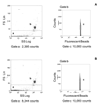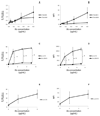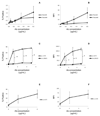Flow cytometric analysis of circulating microparticles in plasma
- PMID: 20235276
- PMCID: PMC2919894
- DOI: 10.1002/cyto.a.20886
Flow cytometric analysis of circulating microparticles in plasma
Abstract
Microparticles, which include exosomes, micro-vesicles, apoptotic bodies and apoptotic microparticles, are small (0.05 - 3 mum in diameter), membranous vesicles that can contain DNA, RNA, miRNA, intracellular proteins and express extracellular surface markers from the parental cells. They can be secreted from intracellular multivesicular bodies or released from the surface of blebbing membranes. Circulating microparticles are abundant in the plasma of normal individuals and can be derived from circulating blood cells such as platelets, red blood cells and leukocytes as well as from tissue sources, such as endothelial and placental tissues. Elevated levels of microparticles are associated with various diseases such as thrombosis (platelet microparticles), congestive heart failure (endothelial microparticles), breast cancer patients (leukocyte microparticles) and women with preeclampsia (syncytiotrophoblast microparticles). Although microparticles can be detected by microscopy, enzyme-linked immunoassays and functional assays, flow cytometry is the preferred method because of the ability to quantitate (fluorescent bead- or flow rate-based method) and because of polychromatic capabilities. However, standardization of pre-analytical and analytical modus operandi for isolating, enumerating and fluorescent labeling of microparticles remains a challenge. The primary focus of this article is to review the preliminary steps required to optimally study circulating in vivo microparticles which include: 1) centrifugation speed used, 2) quantitation of microparticles before antibody labeling, 3) levels of fluorescence intensity of antibody-labeled microparticles, 4) polychromatic flow cytometric analysis of microparticle sub-populations and 5) use of polyclonal antibodies designed for Western blotting for flow cytometry. These studies determine a roadmap to develop microparticles as biomarkers for a variety of conditions.
Copyright 2010 International Society for Advancement of Cytometry.
Figures







Similar articles
-
Detection and measurement of microparticles: an evolving research tool for vascular biology.Semin Thromb Hemost. 2007 Nov;33(8):771-9. doi: 10.1055/s-2007-1000369. Semin Thromb Hemost. 2007. PMID: 18175282 Review.
-
Flow cytometric detection of circulating platelet-derived microparticles in healthy adult horses.Am J Vet Res. 2014 Oct;75(10):879-85. doi: 10.2460/ajvr.75.10.879. Am J Vet Res. 2014. PMID: 25255176 Clinical Trial.
-
Microparticle formation after co-culture of human whole blood and umbilical artery in a novel in vitro model of flow.Cytometry A. 2012 May;81(5):390-9. doi: 10.1002/cyto.a.22010. Epub 2011 Dec 29. Cytometry A. 2012. PMID: 22213485
-
Improved circulating microparticle analysis in acid-citrate dextrose (ACD) anticoagulant tube.Thromb Res. 2014 Feb;133(2):285-92. doi: 10.1016/j.thromres.2013.11.010. Epub 2013 Nov 25. Thromb Res. 2014. PMID: 24360116
-
Overcoming limitations of microparticle measurement by flow cytometry.Semin Thromb Hemost. 2010 Nov;36(8):807-18. doi: 10.1055/s-0030-1267034. Epub 2010 Nov 3. Semin Thromb Hemost. 2010. PMID: 21049381 Review.
Cited by
-
Single-Exosome Counting and 3D, Subdiffraction Limit Localization Using Dynamic Plasmonic Nanoaperture Label-Free Imaging.Adv Nanobiomed Res. 2023 Sep;3(9):2300039. doi: 10.1002/anbr.202300039. Epub 2023 Jul 27. Adv Nanobiomed Res. 2023. PMID: 38384588 Free PMC article.
-
The Role of Circulating Platelets Microparticles and Platelet Parameters in Acute Ischemic Stroke Patients.J Stroke Cerebrovasc Dis. 2015 Oct;24(10):2313-20. doi: 10.1016/j.jstrokecerebrovasdis.2015.06.018. Epub 2015 Jul 11. J Stroke Cerebrovasc Dis. 2015. PMID: 26169549 Free PMC article.
-
Multiparameter flow cytometry: advances in high resolution analysis.Immune Netw. 2013 Apr;13(2):43-54. doi: 10.4110/in.2013.13.2.43. Epub 2013 Apr 30. Immune Netw. 2013. PMID: 23700394 Free PMC article.
-
Extracellular vesicle-driven information mediates the long-term effects of particulate matter exposure on coagulation and inflammation pathways.Toxicol Lett. 2016 Sep 30;259:143-150. doi: 10.1016/j.toxlet.2016.08.002. Epub 2016 Aug 6. Toxicol Lett. 2016. PMID: 27506416 Free PMC article.
-
Non-coding RNAs in saliva: emerging biomarkers for molecular diagnostics.Int J Mol Sci. 2015 Apr 17;16(4):8676-98. doi: 10.3390/ijms16048676. Int J Mol Sci. 2015. PMID: 25898412 Free PMC article. Review.
References
-
- Thery C, Ostrowski M, Segura E. Membrane vesicles as conveyors of immune responses. Nat Rev Immunol. 2009;9:581–593. - PubMed
-
- Valadi H, Ekstrom K, Bossios A, Sjostrand M, Lee JJ, Lotvall JO. Exosome-mediated transfer of mRNAs and microRNAs is a novel mechanism of genetic exchange between cells. Nat Cell Biol. 2007;9:654–659. - PubMed
-
- Luo SS, Ishibashi O, Ishikawa G, Ishikawa T, Katayama A, Mishima T, Takizawa T, Shigihara T, Goto T, Izumi A. Human Villous Trophoblasts Express and Secrete Placenta-Specific MicroRNAs into Maternal Circulation via Exosomes. Biol Reprod. 2009 and others. - PubMed
-
- Thery C, Boussac M, Veron P, Ricciardi-Castagnoli P, Raposo G, Garin J, Amigorena S. Proteomic analysis of dendritic cell-derived exosomes: a secreted subcellular compartment distinct from apoptotic vesicles. J Immunol. 2001;166:7309–7318. - PubMed
-
- Arteaga RB, Chirinos JA, Soriano AO, Jy W, Horstman L, Jimenez JJ, Mendez A, Ferreira A, de Marchena E, Ahn YS. Endothelial microparticles and platelet and leukocyte activation in patients with the metabolic syndrome. Am J Cardiol. 2006;98:70–74. - PubMed
Publication types
MeSH terms
Grants and funding
LinkOut - more resources
Full Text Sources
Other Literature Sources

